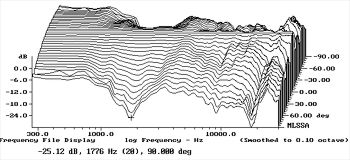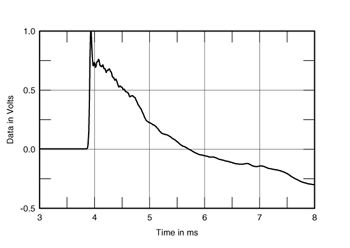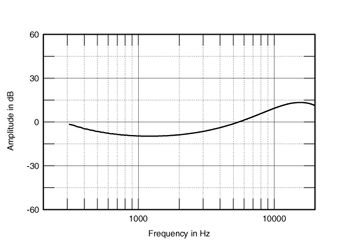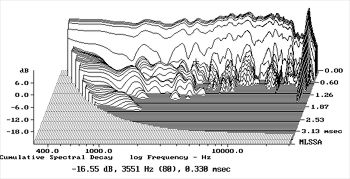| Columns Retired Columns & Blogs |
Thiel CS.5 loudspeaker Measurements part 2
Fig.4 shows a similar set of dispersion curves, this time in the horizontal plane. The '.5's output is maintained across the band to about 20 degrees off-axis. Beyond that angle, a cancellation notch appears in the low treble, and the high treble falls off more rapidly than is usually seen with a 1" dome tweeter. It is difficult to predict the subjective effect of such behavior. I suspect that in all but very dead rooms, the mid-treble flare at the bottom of the tweeter's passband will to some extent compensate for what might otherwise be too polite a tonal balance.

Fig.4 Thiel CS.5, horizontal response family at 50", normalized to response on tweeter axis, from back to front: differences in response 90 degrees-5 degrees off-axis; reference response; differences in response 5 degrees-90 degrees off-axis.
In the time domain, as with all of Jim Thiel's designs, the CS.5 is superbly time-coherent. The impulse response (not shown) has a classic shape, marred only by some ultrasonic ringing from the tweeter, while the step response (fig.5) shows an excellent triangle shape, with only an exaggerated peak indicating an excess of on-axis treble energy. The way in which the curve goes below the time axis to the right of the graph ties in with the speaker's somewhat rich-balanced low frequencies.

Fig.5 Thiel CS.5, step response on tweeter axis at 50" (5ms time window, 30kHz bandwidth).
I normally don't show phase-response plots in Stereophile speaker reviews; except with Vandersteens, Dunlavys, Spicas, and Thiels, there's little point. Conventional speakers all have large amounts of excess phase due both to time delays between the arrivals of the sounds of the different drive-units at the ear/microphone, and to the use of high-order crossovers. Some engineers also argue that, as the ear is not very sensitive to phase distortion, it doesn't matter. It may be true that the ear is forgiving of phase errors, but it appears anecdotally true that speakers featuring only small amounts of excess phase—the difference between the phase response they would have as a minimum-phase system and the phase error they actually have—excel in the area of stereo imaging.
As LB found, the Thiel CS.5 is no exception. Fig.6 shows its excess phase on the tweeter axis plotted against frequency. Other than the slow rise below 600Hz associated with the speaker's bass tuning, and a similar rise in the treble due to the tweeter axis not quite being the optimal axis, the '.5's excess phase remains within ±10 degrees limits for almost all the audioband. Most excellent!

Fig.6 Thiel CS.5, excess phase on tweeter axis at 50" (10 degrees/vertical div.).
Finally, the Thiel's cumulative spectral-decay, or waterfall, plot is shown in fig.7. Other than a trivial amount of hashy hangover at the top of the woofer's passband, the CS.5's decay is very clean throughout the upper midrange and treble, implying a lack of grain to its sound. All in all, these measurements indicate that this little speaker is as well-engineered as its more expensive siblings. Another finely cut gem from the House of Thiel.—John Atkinson

Fig.7 Thiel CS.5, cumulative spectral-decay plot at 50" (0.15ms risetime).
- Log in or register to post comments




































